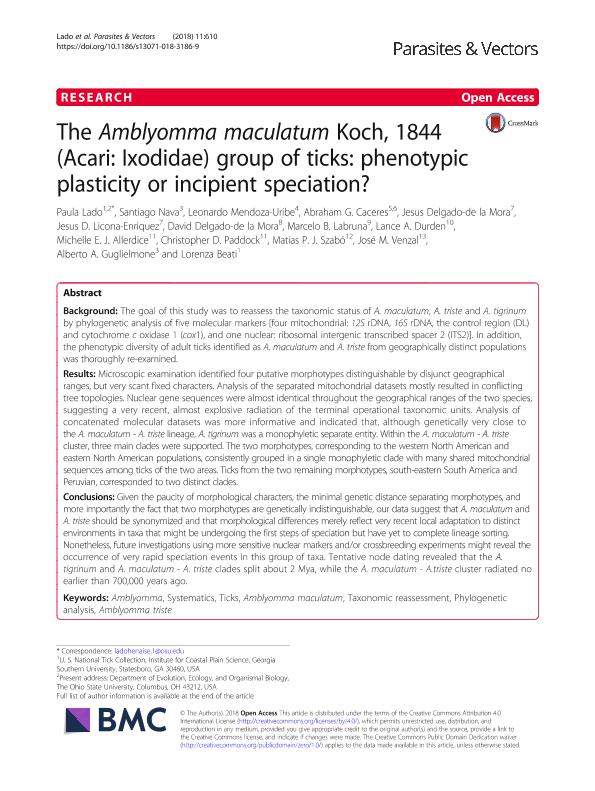Mostrar el registro sencillo del ítem
dc.contributor.author
Lado, Paula
dc.contributor.author
Nava, Santiago

dc.contributor.author
Mendoza Uribe, Leonardo
dc.contributor.author
Caceres, Abraham G.
dc.contributor.author
Delgado de la Mora, Jesus
dc.contributor.author
Licona Enriquez, Jesus D.
dc.contributor.author
Delgado de la Mora, David
dc.contributor.author
Labruna, Marcelo B.
dc.contributor.author
Durden, Lance A.
dc.contributor.author
Allerdice, Michelle E. J.
dc.contributor.author
Paddock, Christopher D.
dc.contributor.author
Szabó, Matias P. J.
dc.contributor.author
Venzal, José M.
dc.contributor.author
Guglielmone, Alberto Alejandro

dc.contributor.author
Beati, Lorenza
dc.date.available
2019-09-06T18:46:02Z
dc.date.issued
2018-11
dc.identifier.citation
Lado, Paula; Nava, Santiago; Mendoza Uribe, Leonardo; Caceres, Abraham G.; Delgado de la Mora, Jesus; et al.; The Amblyomma maculatum Koch, 1844 (Acari: Ixodidae) group of ticks: Phenotypic plasticity or incipient speciation?; BioMed Central; Parasites and Vectors; 11; 11-2018; 1-22; 610
dc.identifier.issn
1756-3305
dc.identifier.uri
http://hdl.handle.net/11336/83067
dc.description.abstract
Background: The goal of this study was to reassess the taxonomic status of A. maculatum, A. triste and A. tigrinum by phylogenetic analysis of five molecular markers [four mitochondrial: 12S rDNA, 16S rDNA, the control region (DL) and cytochrome c oxidase 1 (cox1), and one nuclear: ribosomal intergenic transcribed spacer 2 (ITS2)]. In addition, the phenotypic diversity of adult ticks identified as A. maculatum and A. triste from geographically distinct populations was thoroughly re-examined. Results: Microscopic examination identified four putative morphotypes distinguishable by disjunct geographical ranges, but very scant fixed characters. Analysis of the separated mitochondrial datasets mostly resulted in conflicting tree topologies. Nuclear gene sequences were almost identical throughout the geographical ranges of the two species, suggesting a very recent, almost explosive radiation of the terminal operational taxonomic units. Analysis of concatenated molecular datasets was more informative and indicated that, although genetically very close to the A. maculatum - A. triste lineage, A. tigrinum was a monophyletic separate entity. Within the A. maculatum - A. triste cluster, three main clades were supported. The two morphotypes, corresponding to the western North American and eastern North American populations, consistently grouped in a single monophyletic clade with many shared mitochondrial sequences among ticks of the two areas. Ticks from the two remaining morphotypes, south-eastern South America and Peruvian, corresponded to two distinct clades. Conclusions: Given the paucity of morphological characters, the minimal genetic distance separating morphotypes, and more importantly the fact that two morphotypes are genetically indistinguishable, our data suggest that A. maculatum and A. triste should be synonymized and that morphological differences merely reflect very recent local adaptation to distinct environments in taxa that might be undergoing the first steps of speciation but have yet to complete lineage sorting. Nonetheless, future investigations using more sensitive nuclear markers and/or crossbreeding experiments might reveal the occurrence of very rapid speciation events in this group of taxa. Tentative node dating revealed that the A. tigrinum and A. maculatum - A. triste clades split about 2 Mya, while the A. maculatum - A.triste cluster radiated no earlier than 700,000 years ago.
dc.format
application/pdf
dc.language.iso
eng
dc.publisher
BioMed Central

dc.rights
info:eu-repo/semantics/openAccess
dc.rights.uri
https://creativecommons.org/licenses/by-nc-sa/2.5/ar/
dc.subject
Amblyomma
dc.subject
Amblyomma Maculatum
dc.subject
Amblyomma Triste
dc.subject
Phylogenetic Analysis
dc.subject
Systematics
dc.subject
Taxonomic Reassessment
dc.subject
Ticks
dc.subject.classification
Ciencias Veterinarias

dc.subject.classification
Ciencias Veterinarias

dc.subject.classification
CIENCIAS AGRÍCOLAS

dc.title
The Amblyomma maculatum Koch, 1844 (Acari: Ixodidae) group of ticks: Phenotypic plasticity or incipient speciation?
dc.type
info:eu-repo/semantics/article
dc.type
info:ar-repo/semantics/artículo
dc.type
info:eu-repo/semantics/publishedVersion
dc.date.updated
2019-08-08T18:05:54Z
dc.journal.number
11
dc.journal.pagination
1-22; 610
dc.journal.pais
Reino Unido

dc.journal.ciudad
Londres
dc.description.fil
Fil: Lado, Paula. University of Georgia; Estados Unidos
dc.description.fil
Fil: Nava, Santiago. Instituto Nacional de Tecnología Agropecuaria. Centro Regional Santa Fe. Estación Experimental Agropecuaria Rafaela; Argentina. Consejo Nacional de Investigaciones Científicas y Técnicas. Centro Científico Tecnológico Conicet - Santa Fe; Argentina
dc.description.fil
Fil: Mendoza Uribe, Leonardo. Instituto Nacional de Salud; Perú
dc.description.fil
Fil: Caceres, Abraham G.. Instituto Nacional de Salud; Perú. Universidad Nacional Mayor de San Marcos; Perú
dc.description.fil
Fil: Delgado de la Mora, Jesus. Universidad de Sonora; México
dc.description.fil
Fil: Licona Enriquez, Jesus D.. Universidad de Sonora; México
dc.description.fil
Fil: Delgado de la Mora, David. Universidad de Sonora; México
dc.description.fil
Fil: Labruna, Marcelo B.. Universidade de Sao Paulo; Brasil
dc.description.fil
Fil: Durden, Lance A.. University of Georgia; Estados Unidos
dc.description.fil
Fil: Allerdice, Michelle E. J.. Centers For Disease Control And Prevention. National Center For Infectious Diseases; Estados Unidos
dc.description.fil
Fil: Paddock, Christopher D.. Centers For Disease Control And Prevention. National Center For Infectious Diseases; Estados Unidos
dc.description.fil
Fil: Szabó, Matias P. J.. Universidade Federal de Uberlândia; Brasil
dc.description.fil
Fil: Venzal, José M.. Universidad de la República; Uruguay
dc.description.fil
Fil: Guglielmone, Alberto Alejandro. Instituto Nacional de Tecnología Agropecuaria. Centro Regional Santa Fe. Estación Experimental Agropecuaria Rafaela; Argentina. Consejo Nacional de Investigaciones Científicas y Técnicas. Centro Científico Tecnológico Conicet - Santa Fe; Argentina
dc.description.fil
Fil: Beati, Lorenza. University of Georgia; Estados Unidos
dc.journal.title
Parasites and Vectors

dc.relation.alternativeid
info:eu-repo/semantics/altIdentifier/url/https://parasitesandvectors.biomedcentral.com/articles/10.1186/s13071-018-3186-9
dc.relation.alternativeid
info:eu-repo/semantics/altIdentifier/doi/http://dx.doi.org/10.1186/s13071-018-3186-9
Archivos asociados
